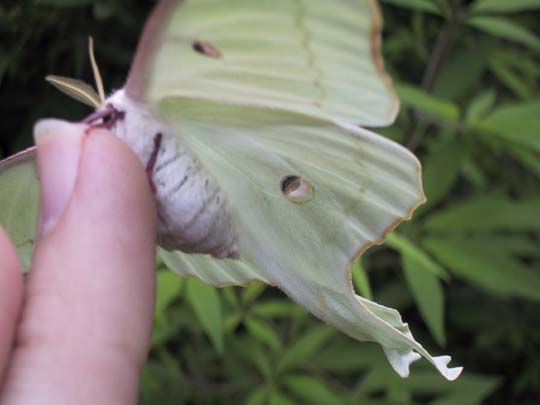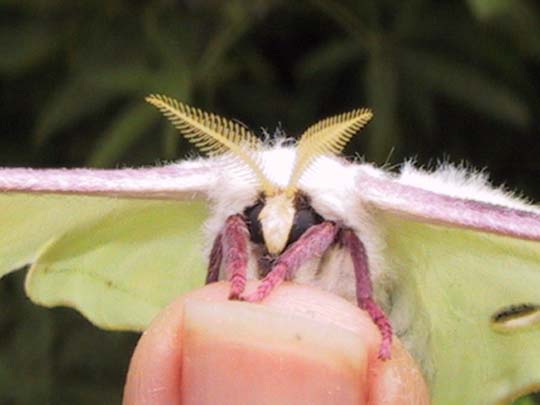Today’s lunchtime surprise:

When I went home for lunch today, I found this delicate creature hanging in the cocoon cage. I was beginning to wonder when they’d start hatching – it’s been at least a couple of weeks since the spinning began. She looks a little smaller than I remember them being – but it’s years since I’ve had one in my hands, and I was smaller then, so the difference in size may be partly just the effect of memory. I need to get a ruler and measure her, but I was doing this on my lunch break – she’s probably got a wingspan of about four inches, give or take a bit, which is about right for the species.

Here, you can see her big ol’ belly full of eggs. She’s far too heavy to fly; she tried it, and fluttered gracefully down to the ground.

I love the purple of the forewings and the legs.

Beautiful!
Absolutely beautiful. And very nicely photographed.
I’m waiting on my wormbabies. They’re all set up in a nice box, oak trees have been scouted for so food won’t be a problem. Now all I have to do is wait for them to hatch and the feeding frenzy to start!
Re: Beautiful!
Thanks!
I hope the wormbabies eat and grow well for you!
Word to the wise – although they will stand crowding as babies, you may need something like a couple of those 58-quart Rubbermaid huge tubs once they get big. They go through a remarkable amount of foliage per worm per day in their largest size, and they tend to get sickly when cramped. I realized after the fact that I left that out of the care-n-feeding info, and didn’t photo the big tubs on the webpage!
I would never have thought moths could be so pretty.
pretty. thanks for sharing!
Re: Beautiful!
I’ve got at least 3 of the 58 qt tubs empty. And I can easily get more.
Wow, she is truly stunning.
Do they normally get that heavy from eggs?! WOW I had no clue. Not remotely. What would they do in nature, hang out in one place as they developed and then lay them and then die?
I’m thinking about …like swallowtails who flutter about and lay their eggs around the yard and then flutter off. To my untrained eye, she seems ok at flying (and really sharp and sniffing out the host parsley plants I have scattered about.)
Do moths lay their eggs usually all in one spot or spread out or what? Now I’m dying of curiousity…
Saturniid moths always have a lot of eggs. It’s one of their survival strategies – each moth lays hundreds of eggs, so that a few will make it through. In nature, the female hangs from her cocoon to dry her wings, and waits for a male to come and mate with her. They mate overnight, and the next evening they separate. She stumbles around the plant she’s on, laying eggs in clusters, until she’s light enough to fly, and then she takes off and lays the remainder of the eggs over a larger area, finding host plants by their smell.
She doesn’t even feed?
WOW.